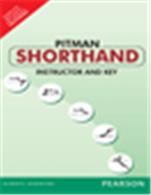Pitman Shorthand Instructor and Key

|
Author(s):
Author:
Issac Pitman
- ISBN:9788177586466
- 10 Digit ISBN:8177586467
-
Price:Rs. 210.00
- Pages:154
- Imprint:AW Professional
- Binding:Paperback
- Status:Available
-
|
Pitman Shorthand has been briefly defined as “the art of representing spoken sounds by character; a system of shorthand”. The system of shorthand was invented by Sir Issac Pitman, who in 1837 published his first treatise on the art. No other system of shorthand designed for the English language has been subjected to tests so prolonged, so diverse, and so severe as those which Pitman Shorthand — as the system is now generally styled — has undergone since its introduction, with the result that it has been most successfully adapted to the practical requirements of all classes of shorthand writers.
|
Table of Content
I. The Consonants
II. The Vowels
III. Intervening Vowels and Position
Grammalogues, Punctuation
IV. Alternative Signs for r and h
V. Diphthongs
Abbreviated w
VI. Phaseography
Tick the
VII. Circle s and z—Left and Right Motion
VIII. Stroke s and z
IX. Large Circles sw and ss or sz
X. Loops st and str
XI. Initial Hooks to Straight Strokes and Curves
XII. Alternative Forms for fr, vr, etc.
Intervening Vowels
XIII. Circle or Loop Preceding Initial Hook
XIV. n and f Hooks
XV. Circles and Loops to Final Hooks
XVI. The shun Hook
XVII. The Aspirate
XVIII. Upward and Downward r
XIX. Upward and Downward l and sh
XX. Compound Consonants
XXI. Vowel Indication
XXII. The Halving Principle (Section 1)
XXIII. The Halving Principle (Section 2)
XXIV. The Doubling Principle
XXV. Diphonic or Two-Vowel Signs
XXVI. Medical Semicircle
XXVII. Prefixes
Negative Words
XXVIII. Suffixes and Terminations
XXIX. Contractions
XXX. Figures, Etc.
Proper Names
XXXI. Note-Taking, Transcription, etc.
XXXII. Essential Vowels
XXXIII. Special Contractions
XXXIV. Advanced Phraseography
XXXV. Intersections
XXXVI. Business Phrases
XXXVII. Political Phrases
XXXVIII. Banking and Stockbroking Phrases
XXXIX. Insurance and Shipping Phrases
XL. Technical and Railway Phrases
XLI. Legal Phrases
XLII. Theological Phrases
XLIII. Special List of Words
XLIV. Shorthand in Practice
Outlines for the Names of Some Chief Cities and Towns
Grammalogues Arranged Alphabetically
Grammalogues Arranged Phonetically
Special List of Contractions
|
Salient Features
Pitman's system has a number of useful features: - It is phonetic. Using very simple strokes of the pencil, sounds are written down and not the letters themselves.
- Vowel sounds are optional and are written with small dots, dashes or other shapes next to the main strokes. This saves time in writing when the consonants alone make clear what the word is. In the majority of cases, the consonants alone can clearly identify an English word.
- The strokes used vary in sound depending on a number of rules. It matters whether the strokes are thick or thin and whether the first stroke of a word is above, on or through the line on the paper. Halving or doubling the length of a stroke is also significant.
- The system developed a large number of "short forms". For example, the letters "th" can represent two sounds (called "unvoiced" and "voiced" th). In Pitman Shorthand they are represented by a curved stroke similar to an open bracket: ( . The thin stroke ( represents the sound of "th" as in the words "thank" and "think", and in fact the single stroke is also used as a short form for these words. The thick stroke ( represents the sound of "th" as in the words "though" and "they"/"them" and is likewise used as the short form for those words as well.
|
|
|
|
|